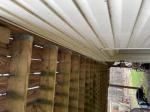Solution for rooftop decks
by Dave
(Vancouver)
Hi all -
I live in a townhouse complex in Vancouver in which all units have a rooftop deck located above a flat section of roof. What we are seeing are a number of decks failing with boards that seriously twist, rendering large sections of deck virtually unusable.
Some background:
1- The decks are built over black roofing membrane and get a decent amount of sun throughout the day (heat?)
2- There is a slope to the roof for drainage so the sleepers get quite thin at the high points - less than 1/2" depth (bad design)
3- The boards (2 x 6) tend to relax during the wet winter months and twist during the dry, hot summer months.
An initial thought was to replace the boards with 1x6 or 1x4 and add the extra inch to the sleepers. This will keep the finished deck flush with the door sills and a metal cap at the front end. We also thought about securing stainless steel or something across the end of the decks to try to resist the twisting.
We are looking for a long term solution and so I thought I'd post here to see if anyone had any thoughts.
Thanks!
Dave
Comments for Solution for rooftop decks
|
||
|
||





























